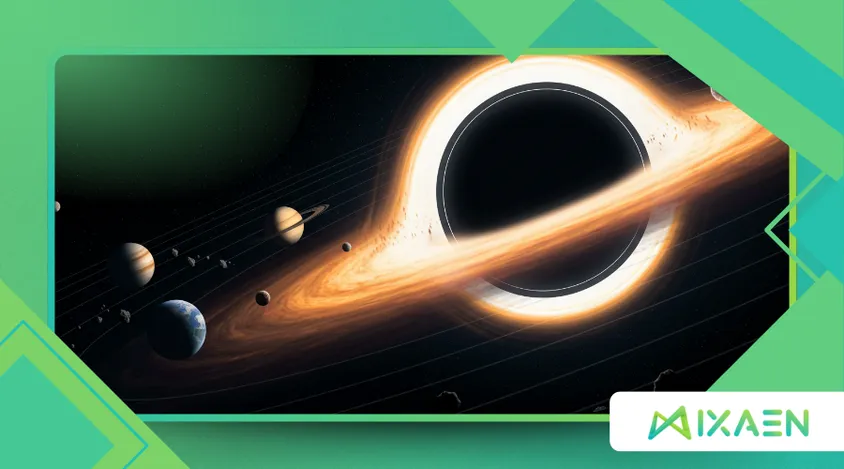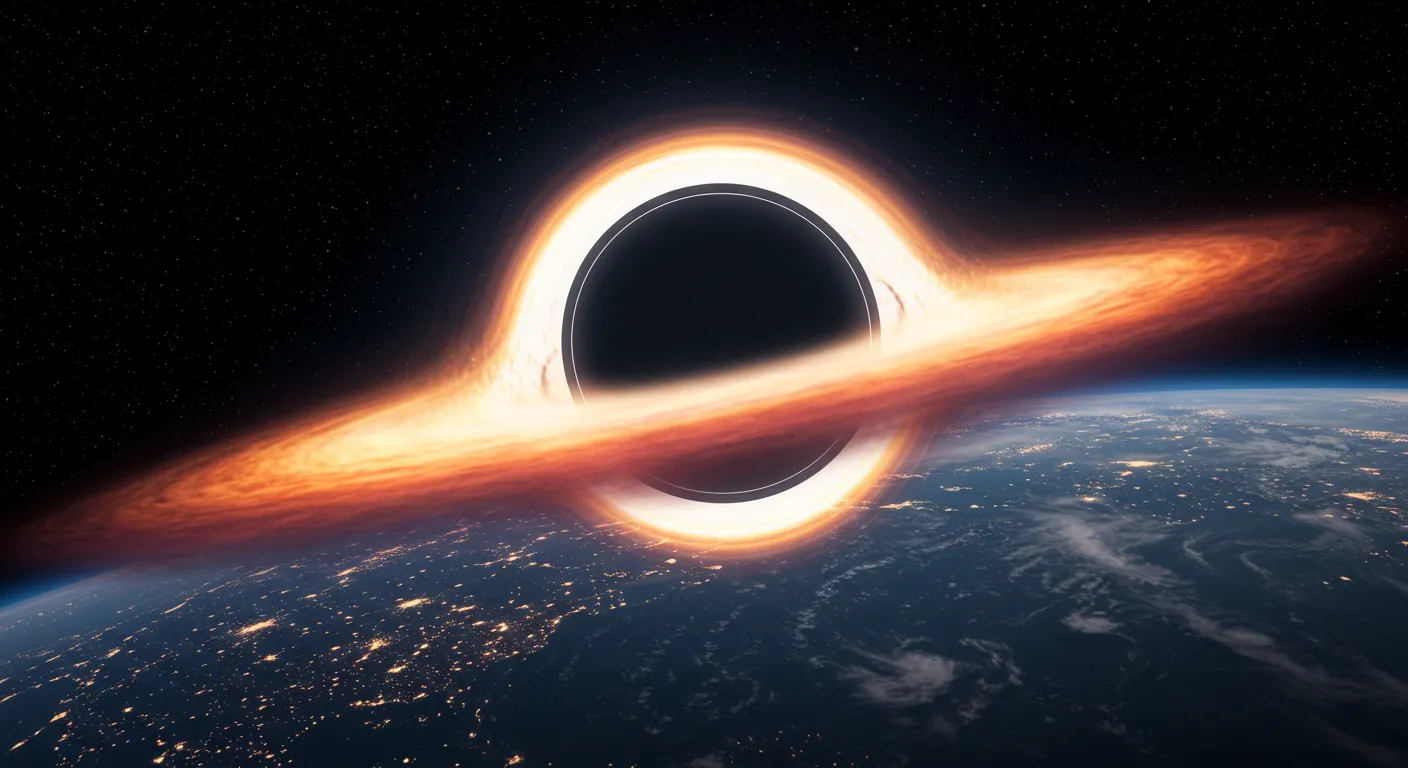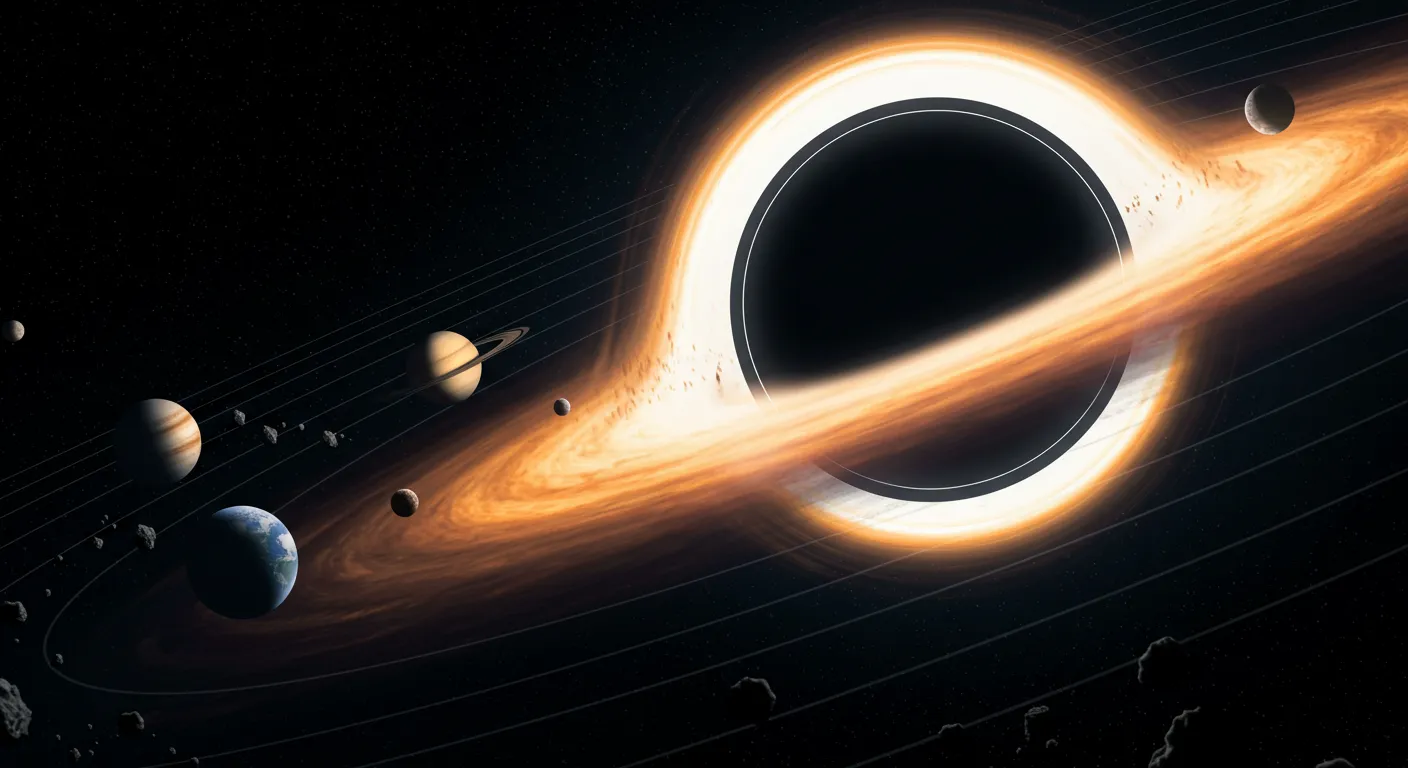Replacing the Sun with a Black Hole – Would Earth Survive?

Imagine a scenario where the Sun, the life-giving star at the center of our solar system, is suddenly replaced by a black hole.
Anúncios
What would happen to Earth?
Would life as we know it cease to exist, or could humanity adapt to such a dramatic change?
Replacing the Sun with a black hole is not just a thought experiment; it’s a fascinating exploration of astrophysics, gravity, and the delicate balance that keeps our planet habitable.
In this article, we’ll dive into the science behind this hypothetical scenario, examining the consequences for Earth and whether survival would even be possible.
The Sun’s Role in Our Solar System
Before we explore the implications of replacing the Sun, it’s essential to understand the critical role our star plays.
The Sun is more than just a source of light and warmth; it’s the gravitational anchor of the solar system.
Its immense mass keeps planets, asteroids, and comets in their orbits, while its energy drives weather patterns, photosynthesis, and the very chemistry of life on Earth.
Without the Sun, the solar system would lose its gravitational center, and Earth would no longer follow its familiar elliptical path.
But what if the Sun’s mass were replaced by a black hole of equal size?
Would the gravitational effects remain the same, or would Earth be pulled into oblivion?
Understanding the Sun’s influence goes beyond just gravity; it also encompasses the solar wind, which protects Earth from cosmic radiation.
This magnetic shield is crucial for maintaining the atmosphere and supporting life, highlighting just how interconnected these celestial dynamics are.
Gravitational Effects: A Black Hole vs. the Sun
One of the most surprising aspects of this scenario is that, from a gravitational perspective, replacing the Sun with a black hole of the same mass wouldn’t immediately alter Earth’s orbit.
According to Newton’s law of universal gravitation, the force of gravity depends on mass and distance, not the size or nature of the object.
A black hole with the Sun’s mass (approximately 1.989 × 10^30 kg) would exert the same gravitational pull on Earth, meaning our planet would continue to orbit as usual—at least initially.
However, the absence of sunlight would have catastrophic consequences.
Without the Sun’s energy, Earth’s surface temperature would plummet.
Research from NASA suggests that within a week, the average global temperature could drop to -18°C (0°F), and within a year, it could reach -73°C (-100°F).
The table below summarizes the temperature changes over time:
| Time After Sun’s Disappearance | Average Global Temperature |
|---|---|
| 1 Week | -18°C (0°F) |
| 1 Month | -40°C (-40°F) |
| 1 Year | -73°C (-100°F) |
In addition to temperature drops, the lack of solar radiation would disrupt atmospheric conditions, leading to severe weather changes.
Storm patterns would likely become erratic, further complicating survival on Earth.
+ Dark Energy: The Cosmic Mystery That Expands the Universe
The End of Photosynthesis and Ecosystems
The most immediate impact of replacing the Sun with a black hole would be the cessation of photosynthesis.
Plants, algae, and cyanobacteria rely on sunlight to convert carbon dioxide and water into energy.
Without this process, the base of the food chain would collapse, leading to the rapid extinction of most plant life.
Herbivores would soon follow, and eventually, carnivores and omnivores, including humans, would face starvation.
Even if humanity could find alternative food sources, such as lab-grown meat or hydroponic systems, the lack of sunlight would disrupt ecosystems in ways we can’t fully predict.
For example, migratory patterns, which are often guided by the Sun, would be thrown into chaos, further destabilizing animal populations.
Moreover, the loss of plant life would not only affect food sources but also impact the carbon cycle, leading to further atmospheric changes.
This cascading effect could result in a hostile environment, making recovery nearly impossible.

The Role of Black Hole Radiation
While black holes are often thought of as cosmic vacuum cleaners, they are not entirely devoid of energy.
The accretion disk—a swirling ring of gas and dust around a black hole—can emit significant amounts of radiation, including X-rays and gamma rays.
If the black hole replacing the Sun were actively consuming matter, this radiation could pose a serious threat to life on Earth.
However, a black hole of the Sun’s mass would have a relatively small accretion disk, and the radiation emitted might not be enough to compensate for the loss of sunlight.
In fact, the radiation could be more harmful than beneficial, potentially sterilizing the planet’s surface over time.
Additionally, the intense gravitational forces near a black hole could lead to tidal forces that might disrupt the stability of Earth’s orbit.
This destabilization could further complicate any potential for life to adapt to the new conditions.
Could Humanity Survive?
Surviving the replacement of the Sun with a black hole would require unprecedented technological advancements.
One possibility is the construction of massive underground habitats powered by nuclear or geothermal energy.
These shelters would need to be self-sustaining, with artificial lighting for agriculture and advanced life-support systems.
Another option might involve relocating Earth itself.
While this sounds like science fiction, some theoretical models suggest that a sufficiently advanced civilization could use gravitational assists or propulsion systems to move a planet to a new star system.
However, such a feat would require technology far beyond our current capabilities.
Moreover, the psychological and social implications of such a drastic relocation would be immense, potentially leading to conflicts over resources and governance.
The focus on survival might overshadow cultural and societal development, creating a dystopian scenario.
++ The Composition of the Universe: What Are Galaxies and Stars Made Of?
The Psychological Impact
Beyond the physical challenges, replacing the Sun with a black hole would have profound psychological effects on humanity.
The Sun has been a constant presence throughout human history, influencing culture, religion, and art.
Its sudden disappearance would likely trigger widespread existential crises and societal upheaval.
Moreover, the absence of daylight would disrupt circadian rhythms, leading to sleep disorders and mental health issues.
Artificial lighting could mitigate some of these effects, but it would be a poor substitute for the natural cycles we’ve evolved with.
Additionally, the long-term psychological effects of living in perpetual darkness could lead to increased rates of depression and anxiety among the population.
Communities might struggle to maintain social cohesion, as the shared experience of sunlight plays a crucial role in human interaction and well-being.
Tables
Table 1: Temperature Changes After Sun’s Disappearance
| Time After Sun’s Disappearance | Average Global Temperature |
|---|---|
| 1 Week | -18°C (0°F) |
| 1 Month | -40°C (-40°F) |
| 1 Year | -73°C (-100°F) |
Table 2: Key Differences Between the Sun and a Black Hole
| Feature | Sun | Black Hole (Solar Mass) |
|---|---|---|
| Energy Emission | Light, heat, solar radiation | Minimal (unless accreting) |
| Gravitational Effects | Keeps planets in orbit | Same as Sun (if mass is equal) |
| Impact on Life | Essential for survival | Catastrophic |
For further reading on the implications of black holes and their effects on space, check out this article on NASA’s website.
A Glimpse into the Far Future
Interestingly, the scenario of replacing the Sun with a black hole isn’t entirely hypothetical.
In about 5 billion years, the Sun will exhaust its nuclear fuel and expand into a red giant before collapsing into a white dwarf.
While this process won’t create a black hole, it highlights the impermanence of stars and the eventual fate of our solar system.
If humanity survives long enough to witness this transformation, we might have the technology to adapt—or even to prevent it.
For now, the idea of replacing the Sun with a black hole serves as a reminder of our dependence on the star that gives us life.
Moreover, this scenario encourages us to invest in research and development of renewable energy sources, ensuring that we are prepared for any future challenges.
By understanding the potential consequences of losing our Sun, we can better appreciate the need for sustainable practices today.

Conclusion: A Delicate Balance
Replacing the Sun with a black hole is a thought-provoking exercise that underscores the delicate balance of our solar system.
While Earth’s orbit might remain stable, the loss of sunlight would render our planet uninhabitable for most forms of life.
Surviving such an event would require extraordinary ingenuity and resilience, pushing the boundaries of human potential.
As we continue to explore the cosmos, scenarios like this remind us of the fragility of our existence and the importance of understanding the forces that shape our universe.
Whether or not we ever face the challenge of replacing the Sun, the pursuit of knowledge ensures that we’re prepared for whatever the future holds.
By exploring the hypothetical scenario of replacing the Sun with a black hole, we gain a deeper appreciation for the star that sustains us.
While the idea may seem far-fetched, it serves as a powerful reminder of the interconnectedness of our solar system and the delicate balance that makes life on Earth possible.
